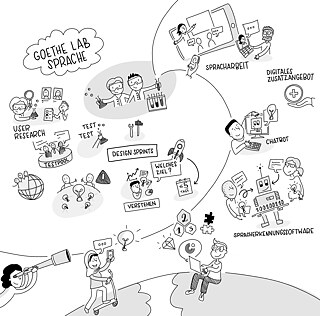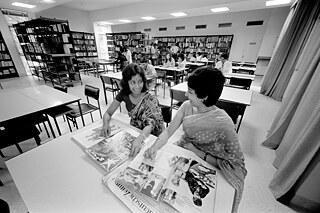The Goethe-Institut
Through the Ages
The Goethe-Institut’s 70-year history is also a story of technical transformation and progress, of the first language labs and futuristic computer art to TikTok lessons and virtual reality in libraries.

Two robot ladies on world tour

Allow us to introduce NAOmi and GAIA, probably the most international and inclusive robot ladies of our time. They have travelled extensively, trapsing across Europe in the middle of the coronavirus pandemic when all borders were still open to humanoid robots even during the lockdown. The two have learned to play football, can dance and sing, speak a number of languages and can even access how their conversational partner prefers to be addressed.

The robot ladies are part of the “Generation A=Algorithm” project, which aims to advance conversation about the use of artificial intelligence (AI) in everyday life. This also involves issues pertaining to the future of cultural and language work: humanoid robots such as NAOmi and GAIA will soon be educating children and caring for the sick, and they are already in use in retirement homes and restaurants today. Their work involves interacting with people from different cultures and sociocultural backgrounds, with different languages and age groups. This requires more than just a touch of intercultural sensitivity. While the Goethe-Institut may have been mostly involved in language and cultural exchange among humans in the early days, robots are an integral part of their activities today.
Cultural exchange for robots too
"Robots in Residence“
What skills does a robot need to have when it goes on tour? NAOmi and GAIA’s programmers in Munich decided their protégés should be able to introduce themselves, tell jokes and lead a Tai Chi exercise, then sent the two robot ladies on a tour with this basic programming. The Japanese-French SoftBank Robotics company created NAOmi and GAIA, humanoid robots already in use in educational institutions worldwide. They are self-learning, meaning they can independently acquire data and learn from it. NAOmi and GAIA have been visiting individual European institutes since June 2020. Local supervisors decide what they want to teach them. The two robots have played football in Bremen, boxed in Groningen, learned to type out picture descriptions in Budapest, and taught in Warsaw.

The project is just one of many that show how much has happened since the Goethe-Institut began offering the first language courses. In the decades that have followed, technical innovation and digitisation have fundamentally changed everyday life, language work, art and culture. From the very beginning, the Goethe-Institut has endeavoured to integrate new technologies into its language and cultural work and to serve as both a critical and supportive voice in the ongoing process of social change.
Learning German in the language lab
Seventy years ago, when the Goethe-Institut opened its door, initially offering language courses in Germany and soon abroad, followed by in-house libraries and international cultural exchange – the digital learning options we enjoy today were still a long way off. Back then, language learners poured over dictionaries and typed on typewriters, participants were contacted on rotary telephones, and course times were posted on notice boards.In the 1960s, language labs with the latest technology were an almost revolutionary innovation in the language classroom. Students could listen to sentences or receive instructions from the teacher over headphones, then repeat and record their responses in the more advanced labs. In 1976, the Goethe-Institut also published the first computer-generated artworks in the “Wege zur Computerkunst” (Paths of Computer Art) exhibition, the oldest of which dated back to the 1950s.
It would be almost two decades before personal computer age dawned and towers and cathode ray tube screens conquered every desk. Horst Weber, a language teacher at the Goethe-Institut in Dublin at the time, still remembers buying his first computer to create worksheets for the classroom. “We language teachers recognized the potential of this technology immediately,” he recalls. Weber looked for interactive teaching content, which was initially distributed on floppy discs and later followed by the first learning programs on CD-ROMs.

In the mid-1990s, the first international institutes began setting up their own websites to network with each other and exchange worksheets. “It was a huge success,” Weber recounts. Instead of waiting days for newspapers or magazines to arrive in the post from Munich, teachers could now work with them on a daily basis. The Goethe-Institut headquarters also jumped on the bandwagon and the Research and Development Department began creating its own interactive learning content. The Institut’s first organisation-wide website went live in 1995: The Goethe-Institut was online three years before Google was founded.
Goethe-Lab language
“Did you write this or run it through DeepL?”
Writing is an important component of learning German at the Goethe-Institut worldwide. Open-ended exercises allow language teachers to see whether learners have mastered the vocabulary and grammar covered. However, language learners often use automated translation programs such as DeepL and Google Translate to complete assignments. To be able to recognize such texts in the future, the Goethe-Institut worked with Humboldt University in Berlin to develop a self-learning program that combines natural language processing methods with machine learning. It can not only successfully detect automated text passages from translation programs; it also helps evaluate the students’ writing exercises.


More than just books
Advances in language work are only a small part of the changes the digital transformation has brought. Other areas – like libraries – have also undergone quite a few twists and turns.
The book-borrowing model seems to have outlived its usefulness in this age of Wikipedia and streaming services when pretty much any piece of information or book is available for download. But this in no way means libraries have lost their importance in recent years – at least not in the world of the Goethe-Institut. Their basic concept, “sharing”, is all the rage – and Goethe-Institut libraries around the world have responded positively.
Bratislava, Solvakiat to this end. “There are quite a few things that you rarely need or would like to try out once,” Döllgast says, explaining the concept. From drills to bread makers, there are purchases that are not really worthwhile on an individual basis. So it makes sense to borrow them from a library instead. Other libraries have set up film studios for public use, as in Addis Ababa in Ethiopia, or office workstations for social entrepreneurs, as in Johannesburg in South Africa. There is also a gamebox here where visitors can try out a selection of independent games from Germany and sub-Saharan Africa. The library in Cairo, Egypt, has set up a makerspace, a creative space where interested patrons can try out new technologies.
The Goethe-Institut is also working on ways to present classical literature and film for users to experience in new ways and has been experimenting with virtual reality technology for a few years now. The multimedia installation “The Cabinet of Dr Caligari,” for example, allowed visitors to walk through the epic film from 1919, while Kafka’s story “The Metamorphosis” came to life in the “VRwandlung” VR installation. “VRwandlung” was enthusiastically received on its world tour of Goethe-Institut libraries from the Czech Republic in 2018. It attracted 35,000 visitors in Minsk, and whether in Ghana or Myanmar, “as soon as word got out, the queue got longer,” says Goran Vulinovic, who oversees VR projects at the Munich headquarters. The “Virtual Bauhaus” was also on world tour in 2019, allowing visitors to jump into a digital rendering of the Dessau Bauhaus.
Combatting fake news and neo-colonialism
The issues raised by the information society have become central to the Goethe-Institut, especially since language, information exchange and intercultural communication have all gone digital. The Goethe-Institut sees part of its mission as helping to shape social and cultural debate in this area.
This includes digital literacy so users can assess what information on the Internet is genuine and recognise fake news. Game developers from Asia, Africa and Latin America created educational games to address digital literacy for the international “Game’n’Train Mixer” project run from February to April 2021. The Goethe-Institut in Moscow organised information workshops with experts. Participants at the online “The Climate Challenge” hackathon, organised by the Goethe-Institut together with Scientists4Future and The Hackathon Company, developed a bot that scans Twitter for tweets on climate change, then assesses if they were posted by an expert and whether the information they contain is accurate.
Neo-colonialism in the digital world is another important buzzword. It raises questions about who actually writes the texts on relevant Internet portals, such as Wikipedia, and what worldview is conveyed in the process. The Westernized perspective of the industrialized nations has frequently dominated to date. This is also true when it comes to programming algorithms for artificial intelligence, where developers often unconsciously pass on racism and stereotypes. Goethe-Institut projects like “Robots in Residence” where NAOmi and GAIA learn new things in different countries and cultures seek to counteract this trend.
Projects like “Whose Knowledge?” address decolonizing the Internet, with edit-a-thons, collaborative meetings to expand Wikipedia to include specific articles and subject areas, in Africa carried out in cooperation with the Open Foundation West Africa, WikimediaZA Foundation and Whose Knowledge, among others. The encyclopaedia is now richer by quite a few new entries on topics like Ethiopian social entrepreneur Bruktawit Tigabu Tadesse.
Articles such as the biography of Ethiopian President Sahlework Zewde are now also available in local languages – Amharic, in this case.
In combination with the diverse discussion events and hackathons organised by the Goethe-Institut worldwide, all of these projects explore just how we want to live in the new digitalized world and point to paths and possibilities for the future. The “A Better Version of Me” exhibition at which artists in Seoul in 2017 and Beijing in 2018 presented tech products that do not yet exist – such as an avatar users can employ to explore their own identity based on their social media presence, or a program for money investors that continues the investment strategy of its users after their death with the assets they leave behind, are all part of this mission.
Incidentally, NAOmi and GAIA, the two robot ladies, will arrive back in Germany in October 2021 and join the closing “Generation A=Algorithm” festival in Dresden in November. This is the place to experience live what makes an algorithmic brain that has lived and learned in different cultures, languages and social groups tick: a thoroughly multicultural artificial intelligence.
Translation: Sarah Smithson-Compton

















